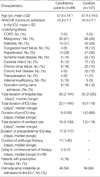1. Eggimann P, Garbino J, Pittet D. Epidemiology of Candida species infections in critically ill non-immunosuppressed patients. Lancet Infect Dis. 2003. 3:685–702.

2. Bassetti M, Righi E, Costa A, Fasce R, Molinari MP, Rosso R, Pallavicini FB, Viscoli C. Epidemiological trends in nosocomial candidemia in intensive care. BMC Infect Dis. 2007. 6:21.

3. Wisplinghoff H, Bischoff T, Tallent SM, Seifert H, Wenzel RP, Edmond MB. Nosocomial bloodstream infections in US hospitals: analysis of 24,179 cases from a prospective nationwide surveillance study. Clin Infect Dis. 2004. 39:309–317.

4. Klingspor L, Tornqvist E, Johansson A, Petrini B, Forsum U, Hedin G. A prospective epidemiological survey of candidaemia in Sweden. Scand J Infect Dis. 2004. 36:52–55.

5. Puzniak L, Teutsch S, Powderly W, Polish L. Has the epidemiology of nosocomial candidemia changed? Infect Control Hosp Epidemiol. 2004. 25:628–633.

6. Morgan J, Meltzer MI, Plikaytis BD, Sofair AN, Huie-White S, Wilcox S, Harrison LH, Seaberg EC, Hajjeh RA, Teutsch SM. Excess mortality, hospital stay, and cost due to candidemia: a case control study using data from population-based candidemia surveillance. Infect Control Hosp Epidemiol. 2005. 26:540–547.
7. Alonso-Valle H, Acha O, Garcia-Palomo JD, Farinas-Alvarez C, Fernandez-Mazarrasa C, Farinas MC. Candidemia in a tertiary care hospital: epidemiology and factors influencing mortality. Eur J Clin Microbiol Infect Dis. 2003. 22:254–257.

8. Jamal WY, El-Din K, Rotimi VO, Chugh TD. An analysis of hospital-acquired bacteremia in intensive care unit patients in a university hospital in Kuwait. J Hosp Infect. 1999. 43:49–56.
9. Gudlaugsson O, Gillespie S, Lee K, Vande Berg J, Hu J, Messer S, Herwaldt L, Pfaller M, Diekema D. Attributable mortality of nosocomial candidemia, revisited. Clin Infect Dis. 2003. 37:1172–1177.

10. Nieto-Rodriguez JA, Kusne S, Manez R, Irish W, Linden P, Magnone M, Wing EJ, Fung JJ, Starzl TE. Factors associated with the development of candidemia and candidemia-related death among liver transplant recipients. Ann Surg. 1996. 223:70–76.

11. McNeil MM, Nash SL, Hajjeh RA, Phelan MA, Conn LA, Plikaytis BD, Warnock DW. Trends in mortality due to invasive mycotic diseases in the United States, 1980-1997. Clin Infect Dis. 2001. 33:641–647.

12. Nolla-Salas J, Stiges-Serra J, Leon-Gil C, Martinez-Gonzalez J, Leon-Regidor MA, Ibanez-Lucia P, Torres-Rodriguez JM. Candidemia in non-neutropenic critically ill patients: analysis of prognostic factors and assessment of systemic antifungal therapy. Intensive Care Med. 1997. 23:23–30.

13. Vincent JL, Anaissie E, Bruining H, Demajo W, el-Ebiary M, Haber J, Hiramatsu Y, Nitenberg G, Nystrom PO, Pittet D, Rogers T, Sandven P, Sganga G, Schaller MD, Solomkin J. Epidemiology, diagnosis, and treatment of systemic Candida infection in surgical patients under intensive care. Intensive Care Med. 1998. 24:206–216.

14. Herbrecht R. Managing the challenges of invasive fungal infections. Int J Antimicrob Agents. 2006. 27:Suppl 1. 1–2.

15. Rex JH, Pappas PG, Karchmer AW, Sobel J, Edwards JE, Hadley S, Brass C, Vazquez JA, Chapman SW, Horowitz HW, Zervos M, McKinsey D, Lee J, Babinchak T, Bradsher RW, Cleary JD, Cohen DM, Danziger L, Goldman M, Goodman J, Hilton E, Hyslop NE, Kett DH, Lutz J, Rubin RH, Scheld WM, Schuster M, Simmons B, Stein DK, Washburn RG, Mautner L, Chu TC, Panzer H, Rosenstein RB, Booth J. National Institute of Allergy and Infectious Diseases Mycoses Study Group. A randomized and blinded multicenter trial of high-dose fluconazole plus placebo versus fluconazole plus amphotericin B as therapy for candidemia and its consequences in nonneutropenic subjects. Clin Infect Dis. 2003. 36:1221–1228.

16. Knaus WA, Draper EA, Wagner DP, Zimmerman JE. APACHE II: a severity of disease classification system. Crit Care Med. 1985. 13:818–829.
17. Blot SI, Vandewoude KH, Hoste EA, Colardyn FA. Effects of nosocomial candidemia on outcomes of critically ill patients. Am J Med. 2002. 113:480–485.

18. Lee YH, Choi HJ, Lee MA. Risk factors for the development of nosocomial candidemia among patients in intensive care unit. Infect Chemother. 2004. 36:219–226.
19. Wey SB, Mori M, Pfaller MA, Woolson RF, Wenzel RP. Hospital-acquired candidemia. The attributable mortality and excess length stay. Arch Intern Med. 1998. 148:2642–2645.
20. Maschmeyer G. The changing epidemiology of invasive fungal infections: new threats. Int J Antimicrob Agents. 2006. 27:Suppl 1. 3–6.

21. Falagas ME, Apostolou KE, Pappas VD. Attributable mortality of candidemia: a systematic review of matched cohort and case control studies. Eur J Clin Microbiol Infect Dis. 2006. 25:419–425.
22. Rolando N, Harvey F, Brahm J, Philpott-Haward J, Alexander G, Casewell M, Fagan E, Williams R. Fungal infection: a common, unrecognized complication of acute liver failure. J Hepatol. 1991. 12:1–9.
23. Rolando N, Philpott-Howard J, Williams R. Bacterial and fungal infection in acute liver failure. Semin Liver Dis. 1996. 16:389–402.

24. Chang CS, Chen GH, Lien HC, Yeh HZ. Small intestine dysmotility and bacterial overgrowth in cirrhotic patients with spontaneous bacterial peritonitis. Hepatology. 1998. 28:1187–1190.

25. Fisher NC, Cooper MA, Hastings JG, Mutimer DJ. Fungal colonisation and fluconazole therapy in acute liver disease. Liver. 1998. 18:320–325.

26. Gomez F, Ruiz P, Schreiber AD. Impaired function of macrophage Fc? receptors and bacterial infection in alcoholic cirrhosis. N Engl J Med. 1994. 331:1122–1128.

27. Guarner C, Runyon BA. Macrophage function in cirrhosis and the risk of bacterial infection. Hepatology. 1995. 22:367–369.

28. Homann C, Varming K, Hogasen K, Mollnes TE, Graudal N, Thomsen AC, Garred P. Acquired C3 deficiency in patients with alcoholic cirrhosis predisposes to infection and increased mortality. Gut. 1997. 40:544–549.

29. Reisner BS, Woods GL. Times to detection of bacteria and yeasts in BACTEC 9240 blood culture bottles. J Clin Microbiol. 1999. 37:2024–2026.

30. Saito T, Senda K, Takakura S, Fujihara N, Kudo T, Iinuma Y, Tanimoto M, Ichiyama S. Detection of bacteria and fungi in BacT/Alert standard blood-culture bottles. J Infect Chemother. 2003. 9:227–232.








 PDF
PDF ePub
ePub Citation
Citation Print
Print



 XML Download
XML Download